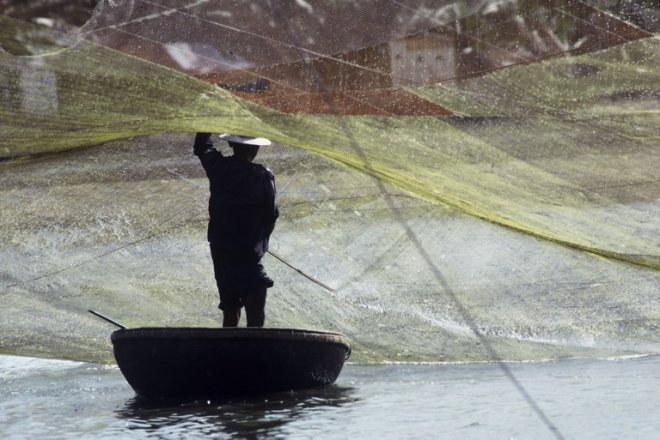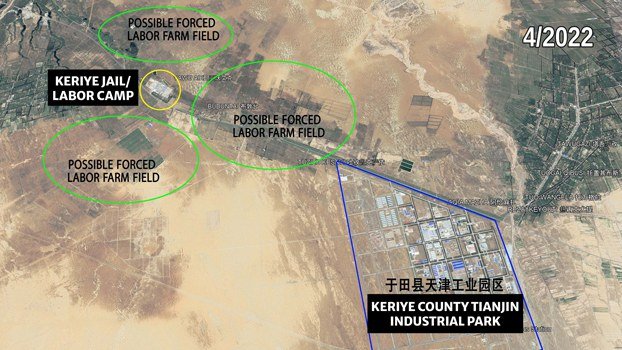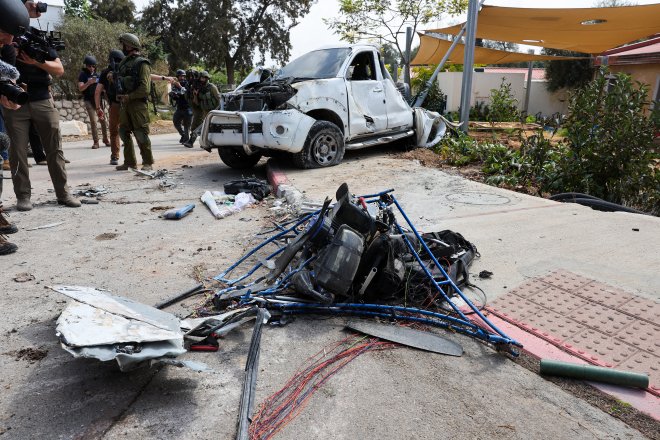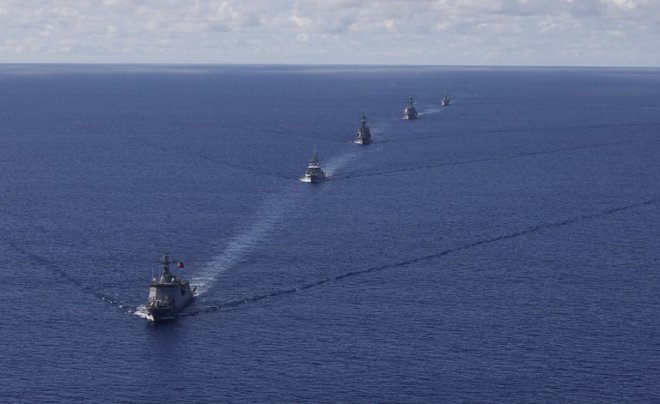Myanmar's casualties of war face a perilous journey
It was pitch black when Ku Phe Law stepped on a landmine and shattered his legs during a skirmish with Myanmar junta troops in eastern Kayah State earlier this year.
Drifting in and out of consciousness, the Karenni Nationalities Defence Force (KNDF) soldier was then taken on a grueling eight-hour car journey in a bid to save his life.
“It was quite far and it took a long time to reach. I don’t know what happened next,” said the 23-year-old, recalling how he ended up in a clinic close to the Thai border.
While his comrades in Loikaw in Kayah State didn’t have much in the way of medical resources, once he was in Thailand, he was outfitted with an artificial leg.
“I was there for 20 days in January, and took a break for a month in the camp. Then I had to go and stay for six months in (Kayah State),” Ku Phe Law added.
Even though his right leg was amputated below the knee, he was lucky to survive.
It has been nearly two years since the military seized power in Myanmar from the democratically elected government of now-imprisoned Aung San Suu Kyi. During that time, coup leader Senior Gen. Min Aung Hlaing has launched a brutal crackdown against the 8,000-strong KNDF, which has links to the pro-democracy alliance and is just one of the myriad forces battling the junta.
On the frontline, the fighting has been fierce, stretching medical resources to breaking point on the Myanmar side of the Thai border. Threadbare hospitals and medical supplies are inadequate for severely wounded soldiers. Crossing the border can at times be the only option.
Despite the perilous journey, many of the casualties of war have been referred to Mae Tao Clinic at Mae Sot in northwestern Thailand, which was established more than 30 years ago to provide free treatment for Burmese refugees and migrants. At least 148 victims of the war have been referred and treated there in the past 10 months, mostly men, but occasionally male and female villagers hit by shelling.
The number of landmine-related cases during that period was 17, the clinic says. In July there were 28 patients undergoing treatment – a monthly record.
“Mostly, they come here for treatment because it’s not easy to go to a local clinic, hospital, or military hospital [in Myanmar] for the sort of wounds they have,” said a medic from the Civil Disobedience Movement that emerged after the Feb. 1, 2021 coup, to oppose military rule. He asked for anonymity for safety reasons.
![]() This picture taken on May 10, 2011 shows a refugee from eastern Myanmar waiting for his prosthesis to be fixed at a workshop at the Mae Tao clinic in the western Thai border town of Mae Sot. Landmine injuries have spiked in 2022. Credit: AFP
This picture taken on May 10, 2011 shows a refugee from eastern Myanmar waiting for his prosthesis to be fixed at a workshop at the Mae Tao clinic in the western Thai border town of Mae Sot. Landmine injuries have spiked in 2022. Credit: AFP![]() The Mae Tao Clinic is a well-established institution amid the often-fluid situation at the Thai-Myanmar border, and is supported by a wide range of donors who help pay for the treatment of patients.
The Mae Tao Clinic is a well-established institution amid the often-fluid situation at the Thai-Myanmar border, and is supported by a wide range of donors who help pay for the treatment of patients.
The clinic works closely with local public health authorities in Thailand, and does not actually assist people with crossing the border.
“They travel through the dark or in the forest. Some people [have] paid a lot of money to get here. It is hugely difficult for people who do not have much money,” the medic said.
“Also, the border bridge is not open legally while the Thai army is watching [all the time]. To come here is very hard,” he said. “Even if they can enter Thailand, they don’t know how to speak [Thai] and are afraid of the police.”
At the height of the Civil Disobedience Movement, doctors and medical students were among the most vocal opponents of the Myanmar military regime. They are still targeted by the junta and many have either left Myanmar or moved to parts of the country controlled by pro-democracy forces.
The conflict, which shows no sign of easing, has exacted a heavy toll. The Thailand-based Assistance Association for Political Prisoners (Burma) has recorded the killings by junta forces of more than 2,600 civilians since the coup. Some 1.1 million others have been displaced. The true death toll could be much higher.
Hospital facilities inside Myanmar can be basic and there is a scarcity of medical supplies, amid continued fighting between the Myanmar army and ethnic armed organizations on the border, and People’s Defense Forces across the country.
“For ordinary injuries, they’re treated in the temporary camps in the forest away from the battlefield, but for the emergency cases [that is different]. They are sent to the hospitals on the Thai border and treated,” said one doctor, who fled to Kayin State from the city of Mawlamyine and asked not to be identified because of fear of reprisals.
“But for our injured comrades who need treatment in Thailand, they have no choice – even though staying in the country is illegal,” the doctor added.
As for KNDF soldier Ku Phe Law, who now works on the administrative side of the ethnic armed organization, his loyalty to the pro-democracy movement remains strong, despite his brush with death.
“I don’t like the dictatorship and what the junta does,” he said. “I have seen many innocent civilians injured and killed – and that shouldn’t happen.”
[圖擷取自網路,如有疑問請私訊]
Drifting in and out of consciousness, the Karenni Nationalities Defence Force (KNDF) soldier was then taken on a grueling eight-hour car journey in a bid to save his life.
“It was quite far and it took a long time to reach. I don’t know what happened next,” said the 23-year-old, recalling how he ended up in a clinic close to the Thai border.
While his comrades in Loikaw in Kayah State didn’t have much in the way of medical resources, once he was in Thailand, he was outfitted with an artificial leg.
“I was there for 20 days in January, and took a break for a month in the camp. Then I had to go and stay for six months in (Kayah State),” Ku Phe Law added.
Even though his right leg was amputated below the knee, he was lucky to survive.
It has been nearly two years since the military seized power in Myanmar from the democratically elected government of now-imprisoned Aung San Suu Kyi. During that time, coup leader Senior Gen. Min Aung Hlaing has launched a brutal crackdown against the 8,000-strong KNDF, which has links to the pro-democracy alliance and is just one of the myriad forces battling the junta.
On the frontline, the fighting has been fierce, stretching medical resources to breaking point on the Myanmar side of the Thai border. Threadbare hospitals and medical supplies are inadequate for severely wounded soldiers. Crossing the border can at times be the only option.
Despite the perilous journey, many of the casualties of war have been referred to Mae Tao Clinic at Mae Sot in northwestern Thailand, which was established more than 30 years ago to provide free treatment for Burmese refugees and migrants. At least 148 victims of the war have been referred and treated there in the past 10 months, mostly men, but occasionally male and female villagers hit by shelling.
The number of landmine-related cases during that period was 17, the clinic says. In July there were 28 patients undergoing treatment – a monthly record.
“Mostly, they come here for treatment because it’s not easy to go to a local clinic, hospital, or military hospital [in Myanmar] for the sort of wounds they have,” said a medic from the Civil Disobedience Movement that emerged after the Feb. 1, 2021 coup, to oppose military rule. He asked for anonymity for safety reasons.
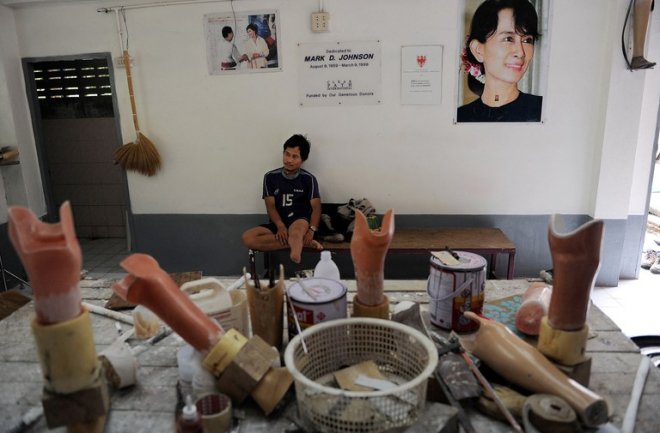 This picture taken on May 10, 2011 shows a refugee from eastern Myanmar waiting for his prosthesis to be fixed at a workshop at the Mae Tao clinic in the western Thai border town of Mae Sot. Landmine injuries have spiked in 2022. Credit: AFP
This picture taken on May 10, 2011 shows a refugee from eastern Myanmar waiting for his prosthesis to be fixed at a workshop at the Mae Tao clinic in the western Thai border town of Mae Sot. Landmine injuries have spiked in 2022. Credit: AFP The Mae Tao Clinic is a well-established institution amid the often-fluid situation at the Thai-Myanmar border, and is supported by a wide range of donors who help pay for the treatment of patients.
The Mae Tao Clinic is a well-established institution amid the often-fluid situation at the Thai-Myanmar border, and is supported by a wide range of donors who help pay for the treatment of patients. The clinic works closely with local public health authorities in Thailand, and does not actually assist people with crossing the border.
“They travel through the dark or in the forest. Some people [have] paid a lot of money to get here. It is hugely difficult for people who do not have much money,” the medic said.
“Also, the border bridge is not open legally while the Thai army is watching [all the time]. To come here is very hard,” he said. “Even if they can enter Thailand, they don’t know how to speak [Thai] and are afraid of the police.”
At the height of the Civil Disobedience Movement, doctors and medical students were among the most vocal opponents of the Myanmar military regime. They are still targeted by the junta and many have either left Myanmar or moved to parts of the country controlled by pro-democracy forces.
The conflict, which shows no sign of easing, has exacted a heavy toll. The Thailand-based Assistance Association for Political Prisoners (Burma) has recorded the killings by junta forces of more than 2,600 civilians since the coup. Some 1.1 million others have been displaced. The true death toll could be much higher.
Hospital facilities inside Myanmar can be basic and there is a scarcity of medical supplies, amid continued fighting between the Myanmar army and ethnic armed organizations on the border, and People’s Defense Forces across the country.
“For ordinary injuries, they’re treated in the temporary camps in the forest away from the battlefield, but for the emergency cases [that is different]. They are sent to the hospitals on the Thai border and treated,” said one doctor, who fled to Kayin State from the city of Mawlamyine and asked not to be identified because of fear of reprisals.
“But for our injured comrades who need treatment in Thailand, they have no choice – even though staying in the country is illegal,” the doctor added.
As for KNDF soldier Ku Phe Law, who now works on the administrative side of the ethnic armed organization, his loyalty to the pro-democracy movement remains strong, despite his brush with death.
“I don’t like the dictatorship and what the junta does,” he said. “I have seen many innocent civilians injured and killed – and that shouldn’t happen.”
[圖擷取自網路,如有疑問請私訊]
|
本篇 |
不想錯過? 請追蹤FB專頁! |
| 喜歡這篇嗎?快分享吧! |
相關文章
AsianNewsCast









